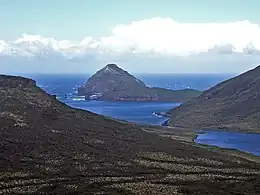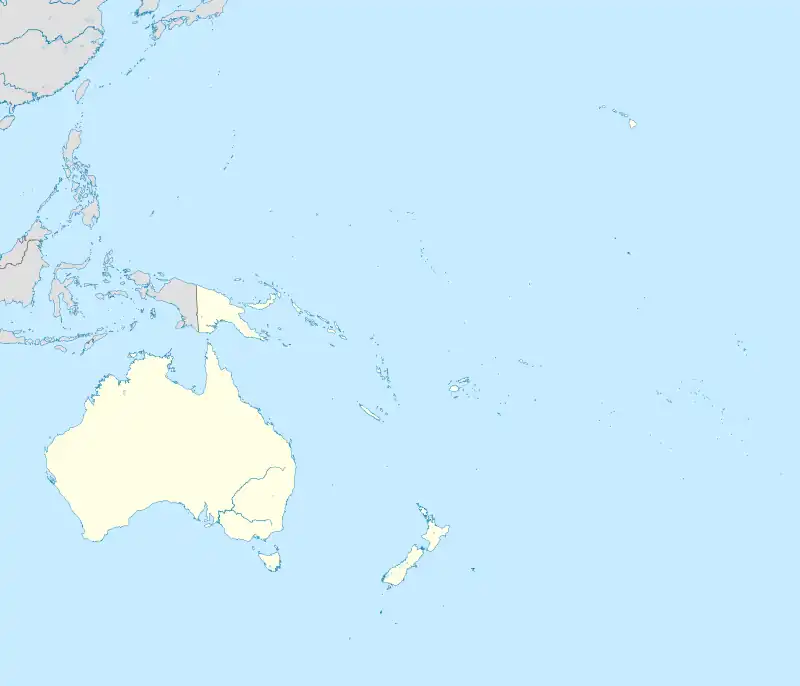Jacquemart Island
Jacquemart Island, one of the islets surrounding Campbell Island in New Zealand, lies 1 km (1⁄2 nmi) south of Campbell Island and is the southernmost island of New Zealand.
 Jacquemart Island in the distance | |
 Jacquemart Island | |
| Geography | |
|---|---|
| Coordinates | 52°37′10″S 169°07′33″E |
| Archipelago | Campbell Island group |
| Area | 19 ha (47 acres) |
| Length | 0.75 km (0.466 mi) |
| Width | 0.5 km (0.31 mi) |
| Highest elevation | 229 m (751 ft)[1] |
| Administration | |
New Zealand | |
| Demographics | |
| Population | Uninhabited |
The name commemorates Captain J. Jacquemart, of the vessel FRWS Vire, that supported the French 1874 Transit of Venus Expedition to Campbell Island.[2]
Geography
Jacquemart Island consists of a stack with an area of 19 ha (47 acres), being about 750 m (2,500 ft) in length by 500 m (1,600 ft) in width and surrounded by precipitous cliffs at least 30 m (100 ft) high at their lowest. Its highest point is about 200 m (650 ft) asl. It is an eroded remnant of basaltic lavas originally laid down on a sedimentary base.
Because of its inaccessibility from the sea, the first visit by humans to the island did not take place until 29 December 1980 when a small party of scientists was landed by helicopter on the summit ridge for a 90-minute survey. Subsequent short visits were made in 1984 and 1997.[3][4]
Flora and fauna
Much of the area of the island above the cliffs is covered with tussock grassland on a substratum of peat undermined with petrel burrows. The environment includes herbfield communities, rock and ledge communities, as well as lichens and cushion plants.[3]
Birds recorded as breeding on Jacquemart include the sooty shearwater, northern giant petrel, grey-backed storm-petrel, light-mantled sooty albatross, brown skua and Campbell shag. Other seabirds which may breed there are common diving-petrel and Cape petrel. New Zealand pipits and common starlings have been seen.[5] A species of cave weta has also been recorded from the island, as well as the Campbell Island leaf-veined slug.[3]
The island is part of the Campbell Island group Important Bird Area (IBA), identified as such by BirdLife International because of its significance as a breeding site for several species of seabirds as well as the endemic Campbell teal and Campbell snipe.[6]
Campbell snipe
Until the Campbell Islands were cleared of introduced rats in 2001, Jacquemart was also the last refuge of the Campbell snipe, a subspecies of Subantarctic snipe first discovered in 1997 and described in 2009. After the eradication of rats the snipe began to recolonise the rest of the group, with a small breeding population discovered in 2005 on southern Campbell Island opposite Jacquemart.[4][7]
See also
References
- "Campbell Island Bicentennial Expedition". 50° South Trust. 26 February 2014. Retrieved 17 October 2017.
- Tobin, William. "The French Expedition to Campbell Island in 1874". Transit of Venus website. Archived from the original on 25 May 2010.
Adapted from I.S. Kerr -"Campbell Island: A History" (A.H. & A.W. Reed, Wellington, 1976)
- Foggo, M.N.; & Meurk, Colin D. (1981). Notes on a visit to Jacquemart Island in the Campbell Island Group. New Zealand Journal of Ecology 4: 29–32.
- Barker, David; Carroll, Jeremy W.A.; Edmonds, Hannah K.; Fraser, James R. & Miskelly, Colin M. (2005), "Discovery of a previously unknown Coenocorypha snipe in the Campbell Island group, New Zealand subantarctic" (PDF), Notornis, 52 (3): 143–149, retrieved 6 March 2016
- New Zealand Journal of Ecology. Vol. 1–4. New Zealand Ecological Society. 1978. p. 31. Retrieved 29 June 2013.
- BirdLife International. (2012). Important Bird Areas factsheet: Campbell Island (and outliers). Downloaded from http://www.birdlife.org on 22 January 2012.
- New Zealand Biodiversity media release – 20 January 2006
External links
- Map of Campbell Island with several surrounding islets, including Jacquemart Island lying south of the main island and Dent island lying northwest of the main island